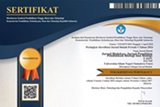In vitro germination of lemon cui (Citrus microcarpa Bunge)
Abstract
Lemon cui (Citrus microcarpa Bunge) is widely utilized by the people of Gorontalo as a cooking ingredient, traditional medicine, cleaning agent, and cosmetic ingredient. This diversity of uses indicates the potential for further development of lemon cui. The initial stage of development that can be undertaken is the mass propagation of high-quality lemon cui seedlings. This study aims to produce lemon cui seedlings using in vitro culture techniques through seed germination.The experimental design used in this study is a Completely Randomized Design (CRD) with four treatments, namely: A: MS0 (without the addition of plant growth regulators and young coconut water); B: MS + 50 mL young coconut water + 0.5 ppm 2,4-D; C: MS + 50 mL young coconut water + 1 ppm 2,4-D; and D: MS + 50 mL young coconut water + 1.5 ppm 2,4-D. The culture medium used was Murashige and Skoog (MS) supplemented with young coconut water and 2,4-dichlorophenoxyacetic acid (2,4-D). The study's results showed that using young coconut water and 2,4-D significantly accelerated the germination of lemon cui seeds. The best result was observed in treatment D, where the citrus seeds exhibited a maximum germination rate of 100%. In addition, the combination of young coconut water and 2,4-D is capable of inducing callus formation during the germination process. The combination of 50 mL of young coconut water and 1.5 ppm 2,4-D is the most effective concentration for inducing germination of lemon cui seeds and callus formation.
Keywords
Full Text:
PDFReferences
Chandra, V. E., Yanti, S. N., Mardhia, & Mahyarudin. (2022). Uji Aktivitas Antibakteri Air Perasan Jeruk Sambal (Citrus microcarpa Bunge) Terhadap Pertumbuhan Escherchia coli. Majalah Kedokteran Andalas, 45(2), 134-143. https://dx.doi.org/10.25077/mka.v45.i2.p134-143.2022
Chen, M. H., Yang, K. M., Huang, T. C., & Wu, M. L. (2017). Traditional Small-Size Citrus from Taiwan: Essential Oils. Bioactive Compounds and Antioxidant Capacity. Medicines, 4(2), 28. https://doi.org/10.3390/medicines4020028.
Damayanti, F., Murdaningsih H. K., T. Herawati., & Darsa, J. S. (2005). Tanggap Eksplan Batang Tiga Kultivar Lili terhadap Kombinasi BA dengan Beberapa Taraf 2,4-D pada Medium MS. Jurnal Pemuliaan Indonesia (Zuriat), 16(1), 60-66. https://doi.org/10.24198/zuriat.v16i1.6784
Dika, O. O., Suryanto, E., & Momuat, L.I. (2021) Karakterisasi dan Aktivitas Antioksidan Serat Pangan dari Tepung Kulit Lemon Cui (Citrus microcarpa). Chemistry Progres, 14(1), 40-47. https://doi.org/10.35799/cp.14.1.2021.34129.
Gunawan, L.W. (1988). Teknik Kultur Jaringan Tanaman. Laboratorium Kultur Jaringan Tanaman, Pusat Antar Universitas, Bioteknologi, Institut Pertanian Bogor.
Hasan, M. N., Hasan, M. R., Foysal, S. H., Hoque, H., Khan, M. F., Bhuiyan, M. F. H., & Prodhan, S. H. (2019). In-Vitro Regeneration of Citrus sinensis (L.) Osbeck from Mature Seed Derived Embryogenic Callus on Different Solid Basal Media. American Journal of Plant Sciences, 10(2), 285-297. https://doi.org/10.4236/ajps.2019.102022.
Husni, E., Yeni, F., & Dachriyanus. (2021) Chemical Contents Profile of Essential Oil from Calamansi (Citrus microcarpa Bunge) Peels and Leaves and Its Antibacterial Activities. 2nd International Conference on Contemporary Science and Clinical Pharmacy 2021 (ICCSCP 2021), 314–322. https://doi.org/10.2991/ahsr.k.211105.046.
Ilahi, M. R., Wowor, V. N. S., & Homenta, H. (2016). Daya Hambat Air Perasan Lemon Cui (Citrus Microcarpa Bunge) terhadap Pertumbuhan Candida albicans yang Diisolasi dari Plat Gigi Tiruan Lepasan Akrilik. Pharmacon Jurnal Ilmiah Farmasi UNSRAT, 5(3), 167-174. https://doi.org/10.35799/pha.5.2016.12955
Junairiah, Wijayanti, E. T., Manuhara, Y. S. W., Ni’matuzahroh, & Sulistyorini, L. (2020). Optimation of Callus induction from piper betle l. Var. nigra explants with various concentrations of coconut water and addition of 2,4-d and bap. Annals of Biology, 36(2), 324-328. https://agribiop.com/.
Katuuk, J. F. P. (2000). Aplikasi mikropogasi anggrek macan (Grammatophyllum scriptum). Jurnal Penelitian IKIP Manado, 1(4), 290-298.
Kindangen, G. D. (2018). Uji Aktivitas Antibakteri Minyak Atsiri Kulit Buah Jeruk Kalamansi (Citrus microcarpa Bunge.) Terhadap Bakteri Staphylococcus aureus dan Escherichia coli, PHARMACON Jurnal Ilmiah Farmasi, 7(4), 62-68. https://doi.org/10.35799/pha.7.2018.21423.
Koltunow, A. M., Hidaka, T., & Robinson, S. P. (1996). Polyembryony in Citrus. Accumulation of seed storage proteins in seeds and in embryos cultured in vitro. Plant Physiol, 110(2), 599-609. https://doi.org/10.1104/pp.110.2.599.
Kristina, N. N., & Syahid, S. F. (2012). The Effect of Coconut Water on In Vitro Shoots MultiplIcation, Rhyzome Yield, and Xanthorrhizol Content of Java Turmeric in the Field. Jurnal Littiri, 18(3), 125-134. http://dx.doi.org/10.21082/jlittri.v18n3.2012.125-134
Mahadi, I., Syafi’I, W., & Agustiani, S. (2015). Kultur Jaringan Jeruk Kasturi (Citrus microcarpa) dengan Menggunakan Hormon Kinetin dan Naftalen Acetyl Acid (NAA). Jurnal Dinamika Pertanian, 30(1), 37-44.
Othman, S. N. A. M., Hassan, M. A., Nahar, L., Basar, N., Jamil, S., & Sarker, S. D. (2016). Essential Oils from the Malaysian Citrus (Rutaceae). Medicinal Plants Medicines, 3(2), 13. https://doi.org/10.3390/medicines3020013
Palma, C. E., Cruz, P. S., Cruz, D. T. C., Bugayong, A. M. S., & Castillo, A. L. (2019). Chemical composition and cytotoxicity of Philippine calamansi essential oil. Industrial Crops and Products, 128(4), 108-114. https://doi.org/10.1016/j.indcrop.2018.11.010.
Palogan, A. N. A., Sitinjak, M. N. Br., Adjen, A. N. T., Pardilawati, C. Y., & Oktarlina, R. Z. (2023). Potensi Minyak Atsiri Jeruk Kalamansi (Citrus microcarpa Bunge) Sebagai Antibakteri Alami: Tinjauan Pustaka. Jurnal Kesehatan dan Agromedicine UNILA, 10(1), 154-158.
Permatasari, U. D. A., Restiani, R., & Prasetyaningsih, A. (2022). Pengaruh Konsentrasi IAA dan Air Kelapa terhadap Pertumbuhan Biji Anggrek Dendrobium phalaenopsis secara In Vitro. Sciscitatio, 3(2), 82-89.
Ragagnin, A .L. S. L., Rodrigues, C. D. M., Costa, G. S., da Silva., G. Z., Machado, C. G., Cruz, S. C. da. S., & da Silva, D. F. P. (2022) Morphology of Seed and Seedlings, and Subtrates in Germination of Citrus limetta, Ciencia Rural, 52(8), e20210377. http://doi.org/10.1590/0103-8478cr20210377
Ragasa, C. Y., Sia, J. E., & Rideout, C. A. (2006) Antimicrobial flavonoid from Citrus microcarpa. CvSU Rev J, 20, 16-19.
Rasud, Y., & Bustaman. (2020). Induksi Kalus Secara In Vitro dari Daun Cengkeh (Syizigium aromaticum L.) dalam Media dengan Berbagai Konsentrasi Auksin. Jurnal Ilmu Pertanian Indonesia (JIPI), 25(1), 67-72. https://doi.org/10.18343/jipi.25.1.67.
Silva, R. C., Belniaki, A. C., Vieira, E. S. N., Cuquel, F. L., & Panobianco, M. (2019). Subsidies for propagation of native species in Brazil with medicinal potential: Calophyllum brasiliense Cambess. Journal of Seed Science, 41(3), 318-327. https://doi.org/10.1590/2317-1545v41n3214007
Souza, J. M. A., Modesto, J. H., Leonel, S., Goncalves, B. H. L., & Ferraz, R. A. (2015). Caracterização física e química dos frutos nos diferentes quadrantes da planta e germinação de sementes do portaenxerto cítrico tangerineira ’Sunki’. Bioscience Journal, 31(2), 425–432. https://doi.org/10.14393/BJ-v31n2a2015-22363
Sholikhah, R. I., Makhziah, M., & Widiwurjani, W. (2022). Effect of IAA Addition and Some Organic Supplements on Growth and Rooting of Cavendish Banana (Musa Acuminata, AAA) In-Vitro. Jurnal Teknik Pertanian Lampung (Journal of Agricultural Engineering), 11(2), 266. https://doi.org/10.23960/jtep-l.v11i2.266-278 .
Syahid, S. T, Kristina, N. N., & Seswita, D. (2010). Pengaruh Komposisi Media terhadap Pertumbuhan Kalus dan Kadar Tanin dari Daun Jati Belanda (Guazuma ulmifolia Lamk) Secara In Vitro. Jurnal Litri, 16(1), 1-5. https://doi.org/10.21082/littri.v16n1.2010.1%20-%205
Thao Nguyen, T. N., Ni Huynh, T. N., Tran, V. T., Hien Dang, C., Dung, H., & Danh Nguyen, T. (2018). Physicochemical Characterization and Bioactivity Evaluation of Essential Oils from Citrus microcarpa Bunge Leaf and Flower. Journal of Essential Oil Research, 30(4), 1-8. https://doi.org/10.1080/10412905.2018.1435428
Wattimena, G. A. (1987). Zat Pengatur Tumbuh Tanaman. Pusat Antar Universitas, Institut Pertanian Bogor.
Wulandari, M., Idiawati, & N., Gusrizal. (2013) Aktivitas Antioksidan Ekstrak n-heksana, Etil Asetat dan Metanol Kulit Buah Jeruk Sambal (Citrus microcarpa Bunge). Jurnal Kimia Khatulistiwa, 2(2), 90-94. https://jurnal.untan.ac.id/index.php/jkkmipa/article/view/3899
Xin, Y. H., Wu, Y. X., Qiao, B., Su, L., Xie, S.Q., & Ling, P. (2022) Evaluation on the phenotypic diversity of Calamansi (Citrus microcarpa) germplasm in Hainan island. Scientific Reports, 12(1), 371. https://doi.org/10.1038/s41598-021-03775-x
Yelnititis. (2012). Pembentukan Kalus Remah dari Eksplan Daun Ramin (Gonystylus bancanus (Miq) Kurz.). Jurnal Pemuliaan Tanaman Hutan. 6(3), 181-194. https://doi.org/10.20886/jpth.2012.6.3.181-194.
DOI: http://dx.doi.org/10.30821/biolokus.v8i1.3952
Refbacks
- There are currently no refbacks.
Copyright (c) 2025 Jurnal Biolokus: Jurnal Penelitian Pendidikan Biologi dan Biologi
indexed by :












